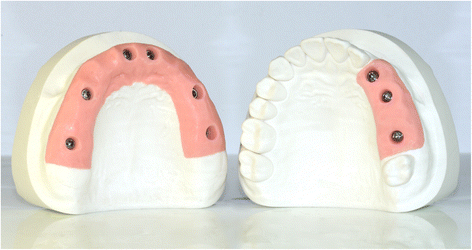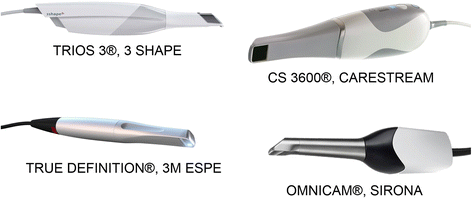Accuracy of four intraoral scanners in oral implantology: a comparative in vitro study
- PMID: 28577366
- PMCID: PMC5455075
- DOI: 10.1186/s12903-017-0383-4
Accuracy of four intraoral scanners in oral implantology: a comparative in vitro study
Abstract
Background: Until now, only a few studies have compared the ability of different intraoral scanners (IOS) to capture high-quality impressions in patients with dental implants. Hence, the aim of this study was to compare the trueness and precision of four IOS in a partially edentulous model (PEM) with three implants and in a fully edentulous model (FEM) with six implants.
Methods: Two gypsum models were prepared with respectively three and six implant analogues, and polyether-ether-ketone cylinders screwed on. These models were scanned with a reference scanner (ScanRider®), and with four IOS (CS3600®, Trios3®, Omnicam®, TrueDefinition®); five scans were taken for each model, using each IOS. All IOS datasets were loaded into reverse-engineering software, where they were superimposed on the reference model, to evaluate trueness, and superimposed on each other within groups, to determine precision. A detailed statistical analysis was carried out.
Results: In the PEM, CS3600® had the best trueness (45.8 ± 1.6μm), followed by Trios3® (50.2 ± 2.5μm), Omnicam® (58.8 ± 1.6μm) and TrueDefinition® (61.4 ± 3.0μm). Significant differences were found between CS3600® and Trios3®, CS3600® and Omnicam®, CS3600® and TrueDefinition®, Trios3® and Omnicam®, Trios3® and TrueDefinition®. In the FEM, CS3600® had the best trueness (60.6 ± 11.7μm), followed by Omnicam® (66.4 ± 3.9μm), Trios3® (67.2 ± 6.9μm) and TrueDefinition® (106.4 ± 23.1μm). Significant differences were found between CS3600® and TrueDefinition®, Trios3® and TrueDefinition®, Omnicam® and TrueDefinition®. For all scanners, the trueness values obtained in the PEM were significantly better than those obtained in the FEM. In the PEM, TrueDefinition® had the best precision (19.5 ± 3.1μm), followed by Trios3® (24.5 ± 3.7μm), CS3600® (24.8 ± 4.6μm) and Omnicam® (26.3 ± 1.5μm); no statistically significant differences were found among different IOS. In the FEM, Trios3® had the best precision (31.5 ± 9.8μm), followed by Omnicam® (57.2 ± 9.1μm), CS3600® (65.5 ± 16.7μm) and TrueDefinition® (75.3 ± 43.8μm); no statistically significant differences were found among different IOS. For CS3600®, For CS3600®, Omnicam® and TrueDefinition®, the values obtained in the PEM were significantly better than those obtained in the FEM; no significant differences were found for Trios3®.
Conclusions: Significant differences in trueness were found among different IOS; for each scanner, the trueness was higher in the PEM than in the FEM. Conversely, the IOS did not significantly differ in precision; for CS3600®, Omnicam® and TrueDefinition®, the precision was higher in the PEM than in the FEM. These findings may have important clinical implications.
Keywords: Accuracy; Intraoral scanners; Oral implants; Precision; Trueness.
Figures






References
-
- Zimmermann M, Mehl A, Mörmann WH, Reich S. Intraoral scanning systems - a current overview. Int J Comput Dent. 2015;18(2):101–129. - PubMed
-
- Logozzo S, Zanetti EM, Franceschini G, Kilpela A, Makynen A. Recent advances in dental optics – Part I: 3D intraoral scanners for restorative dentistry. Optic Lasers Eng. 2014;54(3):203–221. doi: 10.1016/j.optlaseng.2013.07.017. - DOI
-
- Wismeijer D, Mans R, van Genuchten M, Reijers HA. Patients' preferences when comparing analogue implant impressions using a polyether impression material versus digital impressions (Intraoral Scan) of dental implants. Clin Oral Implants Res. 2014;25(10):1113–1118. doi: 10.1111/clr.12234. - DOI - PubMed
Publication types
MeSH terms
Substances
LinkOut - more resources
Full Text Sources
Other Literature Sources
Medical
Research Materials

